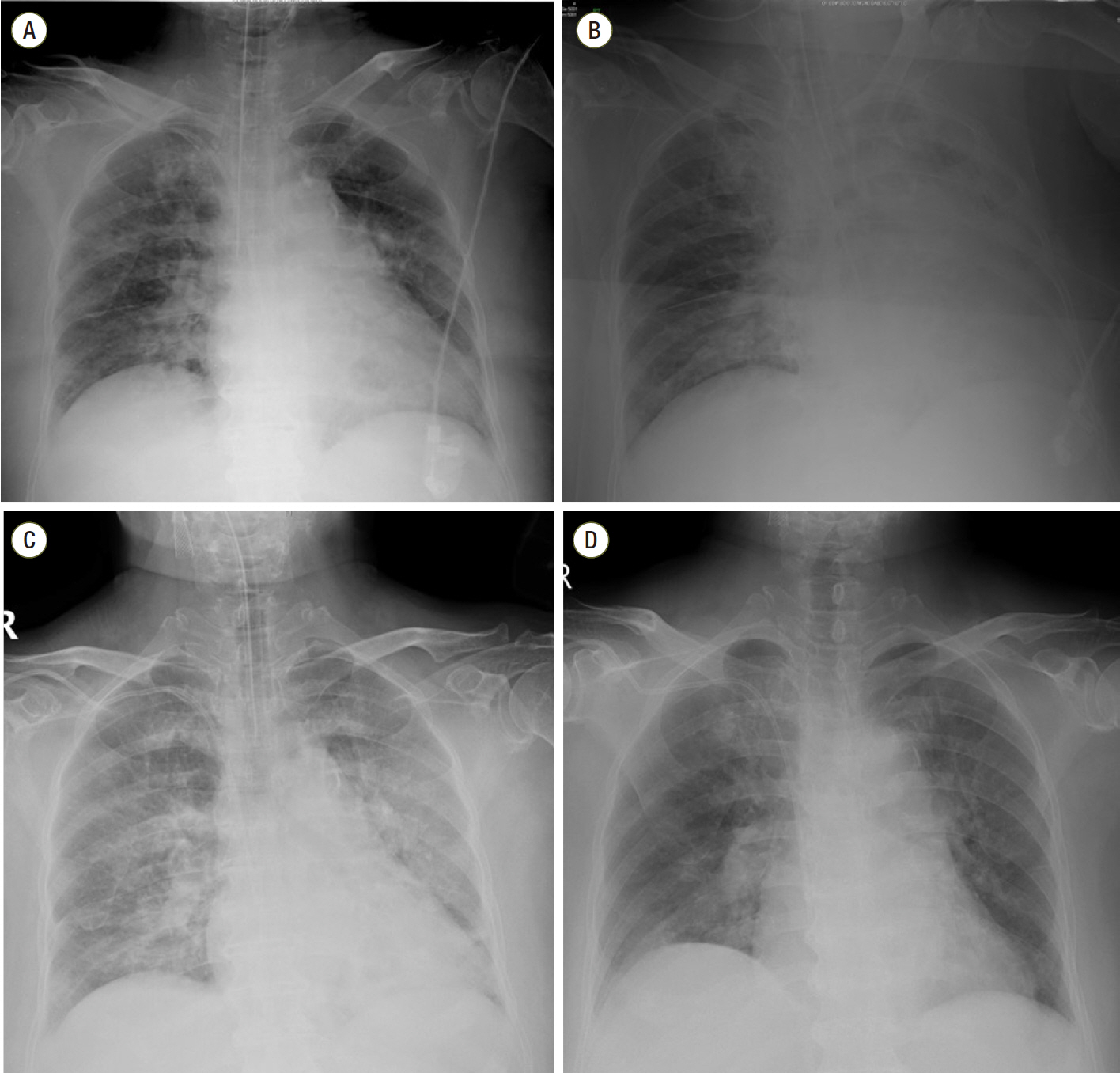Korean J Crit Care Med.
2016 May;31(2):118-122. 10.4266/kjccm.2016.31.2.118.
Recurrent Desaturation Events due to Opioid-Induced Chest Wall Rigidity after Low Dose Fentanyl Administration
- Affiliations
-
- 1Department of Anesthesiology and Pain Medicine, Anesthesia and Pain Research Institute, Yonsei University College of Medicine, Seoul, Korea. NSWKSJ@yuhs.ac
- KMID: 2350918
- DOI: http://doi.org/10.4266/kjccm.2016.31.2.118
Abstract
- Opioid-induced chest wall rigidity is an uncommon complication of opioids. Because of this, it is often difficult to make a differential diagnosis in a mechanically ventilated patient who experiences increased airway pressure and difficulty with ventilation. A 76-year-old female patient was admitted to the intensive care unit (ICU) after surgery for periprosthetic fracture of the femur neck. On completion of the surgery, airway pressure was increased, and oxygen saturation fell below 95% after a bolus dose of fentanyl. After ICU admission, the same event recurred. Manual ventilation was immediately started, and a muscle relaxant relieved the symptoms. There was no sign or symptom suggesting airway obstruction or asthma on physical examination. Early recognition and treatment should be made in a mechanically ventilated patient experiencing increased airway pressure in order to prevent further deterioration.
MeSH Terms
Figure
Reference
-
References
1. Scamman FL. Fentanyl-O2-N2O rigidity and pulmonary compliance. Anesth Analg. 1983; 62:332–4.
Article2. Coruh B, Tonelli MR, Park DR. Fentanyl-induced chest wall rigidity. Chest. 2013; 143:1145–6.
Article3. Dimitriou V, Zogogiannis I, Liotiri D, Wambi F, Tawfeeq N, Koumi A, et al. Impossible mask ventilation after an unusually low dose fentanyl-induced muscle rigidity in a patient with essential tremor: a case report and review of the literature. Middle East J Anaesthesiol. 2014; 22:619–22.4. Rim SK, Kim JI, Son YB, Lee JH. Muscular rigidity and pulmonary edema following administration of low dose fentanyl: a case report. Korean J Crit Care Med. 2012; 27:197–201.5. Klausner JM, Caspi J, Lelcuk S, Khazam A, Marin G, Hechtman HB, et al. Delayed muscular rigidity and respiratory depression following fentanyl anesthesia. Arch Surg. 1988; 123:66–7.
Article6. Kang BJ, Kim SH. Opioid-induced muscle rigidity with a delayed manifestation misunderstood as a tension pneumothorax: a case report. Korean J Pain. 2008; 21:66–70.
Article7. Vankova ME, Weinger MB, Chen DY, Bronson JB, Motis V, Koob GF. Role of central mu, delta-1, and kappa-1 opioid receptors in opioid-induced muscle rigidity in the rat. Anesthesiology. 1996; 85:574–83.8. Soares JH, Brosnan RJ, Smith A, Mayhew PD. Rabbit model of chest wall rigidity induced by fentanyl and the effects of apomorphine. Respir Physiol Neurobiol. 2014; 202:50–2.
Article9. Lui PW, Lee TY, Chan SH. Involvement of coerulospinal noradrenergic pathway in fentanyl-induced muscular rigidity in rats. Neurosci Lett. 1990; 108:183–8.
Article10. Lui PW, Lee TY, Chan SH. Involvement of locus coeruleus and noradrenergic neurotransmission in fentanyl-induced muscular rigidity in the rat. Neurosci Lett. 1989; 96:114–9.
Article11. Viscomi CM, Bailey PL. Opioid-induced rigidity after intravenous fentanyl. Obstet Gynecol. 1997; 89(5 Pt 2):822–4.
Article12. Comstock MK, Carter JG, Moyers JR, Stevens WC. Rigidity and hypercarbia associated with high dose fentanyl induction of anesthesia. Anesth Analg. 1981; 60:362–3.
Article13. Jaffe TB, Ramsey FM. Attenuation of fentanyl-induced truncal rigidity. Anesthesiology. 1983; 58:562–4.
Article14. Ackerman WE, Phero JC, Theodore GT. Ineffective ventilation during conscious sedation due to chest wall rigidity after intravenous midazolam and fentanyl. Anesth Prog. 1990; 37:46–8.15. Mannam P, Siegel MD. Analytic review: management of life-threatening asthma in adults. J Intensive Care Med. 2010; 25:3–15.
Article16. Neidhart P, Burgener MC, Schwieger I, Suter PM. Chest wall rigidity during fentanyl- and midazolamfentanyl induction: ventilatory and haemodynamic effects. Acta Anaesthesiol Scand. 1989; 33:1–5.
Article17. Walker PE, Marshall M. Bronchial lavage in status asthmaticus. Br Med J. 1969; 3:31–2.
Article18. Thompson HT, Pryor WJ. Bronchial lavage in the treatment of obstructive lung disease. Lancet. 1964; 2:8–10.
Article
- Full Text Links
- Actions
-
Cited
- CITED
-
- Close
- Share
- Similar articles
-
- Inhibitory Effects of Cough Reflex Induced from Fentanyl According to the Dose of Propofol
- Chest Wall Rigidity after Intravenous Administration of Fentanyl
- Opioid-induced Muscle Rigidity with a Delayed Manifestation Misunderstood as a Tension Pneumothorax: A case report
- Muscular Rigidity and Pulmonary Edema Following Administration of Low Dose Fentanyl: A Case Report
- Severe muscular rigidity following the usual analgesic dose of meperidine in the child at postanesthetic recovery room: A case report


